Chapter: Psychology: Perception
Form Perception: What Is It?: The Importance of Organization
The Importance
of Organization
It seems, then, that we’ll need a
great number of feature lists (due to the sheer number of objects we can
recognize). We’ll also need flexibility in how we use the feature lists (to
address the diversity of views we get of each object, and the problem of
partial views). But there’s still another problem for us to confront: It turns
out that the catalog of features we rely on—and so the starting point for our
recognition of objects in the world—depends on how we interpret the visual input.
This role for interpretation can
be demonstrated in several ways. One is that we choose to ignore many of the
features available to our visual system, basing our recog-nition only on a
subset of the features that are actually in view. To make this idea con-crete,
consider Figure 5.3. The pattern in the man’s shirt contains many lines and
angles, but we give them little priority when analyzing the scene. Instead, we
focus on the features defining the outline of the man’s body and telling us
that this is, in fact, a picture of a man wearing sunglasses. Likewise, we
ignore the outline of the shadows cast by the trees because we realize that the
features making up this outline don’t tell us much about the identity of the
objects in the picture. It seems, then, that we somehow choose which features
“matter” for our recognition and which features are incidental.
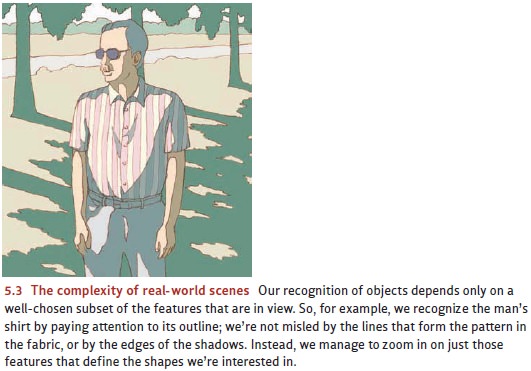
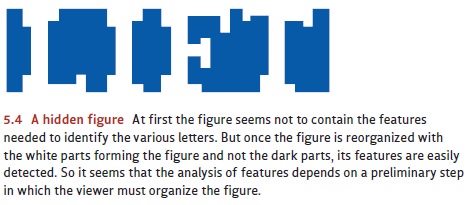
Figure 5.4 illustrates a
different type of interpretation. These dark shapes seem meaningless at first,
but after a moment most people find a way to reorganize the fig-ure so that the
familiar letters come into view. But let’s be clear about what this means. At
the start, the form doesn’t seem to contain the features we need to identify
the L , the I, and so on—and so we don’t detect these letters. Once we’ve
reorganized the form,though, it does contain the relevant features and so we
immediately recognize the let-ters. Apparently, therefore, the catalog of
features present in this figure depends on how we interpret its overall form.
Based on one interpretation, the features defining these letters are absent—and
so we can’t detect the letters or the word LIFT.
With a different interpretation, the features are easily visible and we can
immediately read the word. It seems, then, that features are as much “in the
eye of the beholder” as they are in the figure itself.
As a related example, consider
Figure 5.5. Here, most people easily perceive two com-plete triangles—one on
the orange background, one on the green. But again, the fea-tures of these
triangles aren’t present; specifically, the sides
of the triangle aren’t marked in the figure at all. However, the perceiver
organizes the overall form so that the missing sides are filled in—she’s
essentially creating the features for herself. Once that’s done, she can
clearly perceive the triangles.
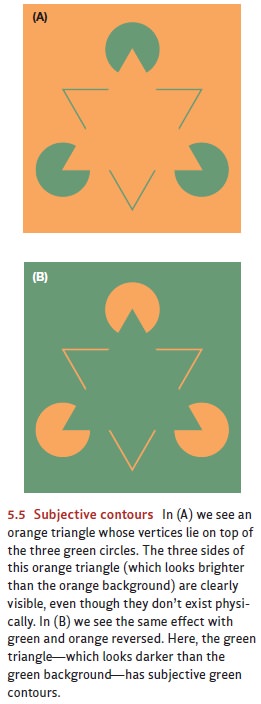
PERCEPTUAL PARSING
The previous examples powerfully
suggest that the perception of form depends both on feature input—that is,
what’s actually in front of your eyes—and on how you organize and interpret the
form. But what exactly does it mean for a perceiver to “interpret” a form, or
to find an “organization” within a figure? And why do you end up with one
interpretation and not another? Why, for example, do most people decide that
Figure 5.5 should be organized in a way that connects the angles so that they
become parts of a single form rather than treating them as separate forms?
Questions like these were crucial
for Gestalt psychology, a school of
psychology that emphasized that organization is an essential feature of all
mental activity: We under-stand the elements of the visual input as linked to
each other in a certain way, and the identity of these elements depends on the
linkage. (That’s why in Figure 5.5, we perceive the round elements as intact
circles, each partially hidden by another form, rather than as a series of
“Pac-Man” figures.) Likewise, we appreciate a work of music because we perceive
the individual notes as forming a cohesive whole. Similarly, our thoughts have
meaning only in relationship to each other. In all cases, the Gestalt
psychologists wanted to ask how this organization was achieved, and how it
influenced us. (The word Gestalt is
derived from a German word meaning “form” or “appearance.”)
Gestalt psychologists described
several aspects of this organization and identified several principles that
guided it. Some of the principles are concerned with the way you parse the input—that is, how you
separate a scene into individual objects, linkingtogether the parts of each
object but not linking one object’s parts to some other object. To make this
idea concrete, consider the still life in Figure 5.6. To make sense of this
pic-ture, your perception must somehow group the elements of the scene
appropriately.
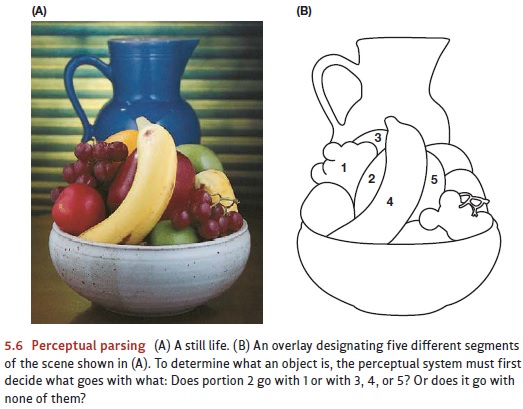
Portion 2 (part of the apple)
must be united with portion 5 (more of the apple), even though they’re
separated by portion 4 (a banana). Portion 2 should not be united with portion
1 (a bunch of grapes), even though they’re adjacent and about the same color.
The bit of the apple hidden from view by the banana must somehow be filled in,
so that you perceive an intact apple rather than two apple slices. All of these
steps involved in deciding which bits go with which other bits fall under the
label of parsing.
What cues guide you toward
parsing a stimulus pattern one way rather than another? The answer involves
both feature information and information about the larger-scale pattern. For
example, we tend to interpret certain features (such as a T-junction—Figure
5.7) as indicating that one edge has disappeared behind another; we interpret
other features differently. In this way, “local” informa-tion—information
contained in one small part of the scene—helps
guide our parsing. But “global”
information—information about the whole scene—is also crucial. For example,
perceivers tend to group things together according to a principle of similarity—meaning that, all other
things being equal, they group together figures that
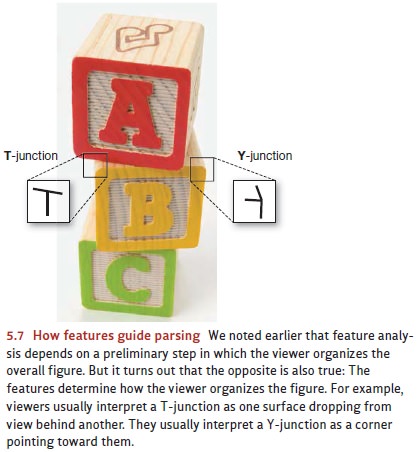

resemble each other. So in Figure
5.8A, we group blue dots with blue dots, red with red. Perceivers are also
influenced by proximity—the closer
two figures are to each other, the more we tend to group them together
perceptually (for more on these principles of perceptual organization, see
Figure 5.8; Palmer, 2002; Wertheimer, 1923).
Parsing is also guided by several
other principles, including good
continuation— a preference for organizations in which contours continue
smoothly along their orig-inal course. This helps us understand why portions 2
and 5 in Figure 5.6 are grouped together as parts of a single object; but good
continuation can also be documented in much simpler stimuli (Figure 5.8C). Good
continuation is also relevant to Figure 5.5. Some theorists interpret the subjective contours visible in this
figure as a spe-cial case of good continuation. In their view, the contour is
seen to continue along its original path—even, if necessary, jumping a gap or
two to achieve this continuation (Kellman & Shipley, 1991; Kellman,
Garrigan, & Shipley, 2005).
FIGURE AND GROUND
Another part of visual
organization is the separation of the object from its setting, so that the
object is seen as a coherent whole, separate from its background. This
sepa-ration of figure and ground allows you to focus on just the
banana in Figure 5.6, treating everything else in the scene as merely the
backdrop for the banana. But the separation of figure and ground is just as
important with simpler and entirely unfamil-iar figures. In Figure 5.9A, the
white splotch appears to most people as the figure and is
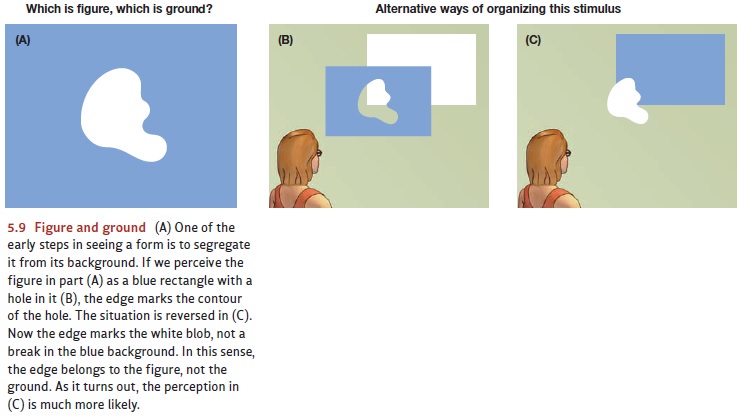
perceived as closer to the viewer
than the blue region (which is seen as the ground) as shown in 5.9c. The edge
between the blue and white regions is perceived as part of the figure, defining
its shape. The same edge does not mark a contour for the blue region but merely
marks the point at which the blue region drops from view.
Of course, you can usually
identify a figure so quickly and easily that it feels like this specification
is somehow specified by the stimulus itself and is not an element of your
interpretation. But the fact remains that identifying the figure, like all
aspects of per-ceptual organization, is up to you. This is most evident
whenever you realize there’s more than one way to interpret a given stimulus—as
in Figure 5.10, which can be seen either as a white vase or as two blue faces
in profile. This reversible figure
makes it clear that the stimulus itself is neutral in its organization. What is
figure and what is ground, it seems, depends on how we look at it.
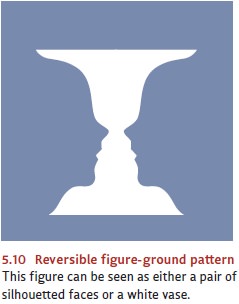
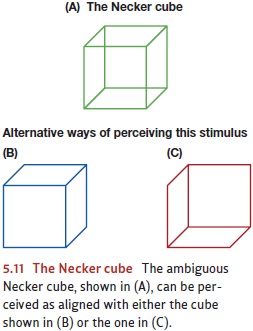
Other examples point to the same
broad conclusion and highlight the perceiver’s active role in interpreting the
input. Is Figure 5.11A—the Necker cube—aligned with the solid cube shown in
Figure 5.11B, so we’re viewing it from above? Or is it aligned with the cube
shown in Figure 5.11C, so we’re viewing it from below? Most people can organize
the Necker cube in either way, so they first perceive it to have one
orientation and then the other. Apparently, then, the organization is not
specified by the figure itself but is instead up to the perceiver.
All of these observations suggest
that perception is less “objective” than one might suppose, because what we
perceive is, it seems, often determined by how we interpret or organize the
input. At the same time, it’s important to realize that perceivers’ infer-ences
and interpretations tend to be neither foolish nor random. Quite the contrary:
Our interpretations of the sensory input are, first of all, shaped by our
experience; and they’re correct far more often than not (Enns, 2004). Likewise,
the interpretations themselves tend to be quite logical, as if our visual
system always follows certain rules. We’ve already mentioned some of these
rules—a preference for grouping similar
things together, for example, or a preference for parsing the input so that it
creates smooth contours. But other rules also guide us: For example, we seem to
prefer per-ceptual interpretations that explain all the information contained within the stimu-lus, and so we avoid
interpretations that would explain only bits and pieces of the stimulus. We
also seem to avoid interpretations that would involve some contradic-tion, such
as perceiving a surface to be both opaque and transparent. What’s more, we seem
to avoid interpretations that depend on accident or coincidence. (“This is what
the form would look like if viewed from exactly the right position.”) Of
course, no one claims that the perceptual apparatus is literally proceeding
through a sequence of log-ical steps, weighing each of these rules in turn.
Still, our perception does seem guided by these principles, so that our
interpretations of the input will be logical and usually correct (Figure 5.12).
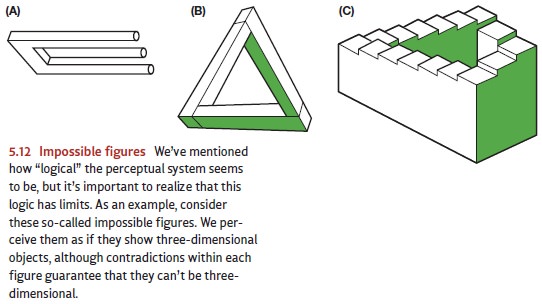
Related Topics